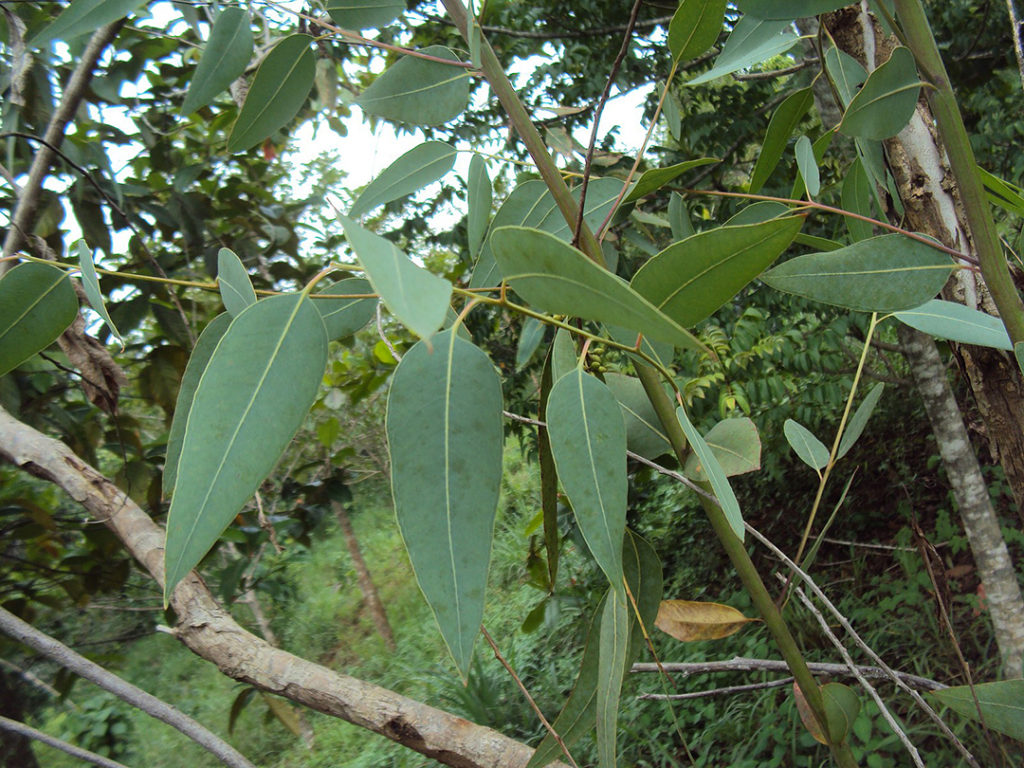
Guadeloupe
Red Gum Tree
Eucalyptus camaldulensis

General Description / Cultural Significance
Guadeloupe is a popular destination for tourists, known for its pure beaches and beautiful mountains, with long streams running through its dense vegetation. This is where the red gum trees, Eucalyptus camaldulensis, have grown, as well as along the coast with a variety of other natural vegetation such as mangroves, sea grapes, and mango trees. Red gum trees were once widely distributed near waterways that are prone to flooding because their seeds require this flooding to flourish. Red gum trees are perennial and have smooth white bark and white flowers that bloom in the summertime, popular as ornamental shade trees. However, they are named for their red wood, and desired because of it, used in Grenada to craft furniture or floors. They are used for construction of fences and outdoor items because their wood is resistant to rot.
The wood of the red gums contains high levels of polyphenols that are a natural antibiotic when combined with the air, benefitting both living trees and people. Polyphenols also reduce chronic inflammation and blood pressure. This experience has played a role in the health and health practices of Guadeloupeans. The essential oil of Eucalyptus camaldulensis is used for medicinal purposes because of its wide range of effects, as a cough remedy, tonic, astringent, and antiseptic. The tree was part of the original old growth and is valued not only for its environmental role within the landscape, but for its social and medical uses that make it so important to Guadeloupeans’ common heritage. The essential oil is also antioxidant, antifungal, antibacterial, and a mosquito repellant.
Climate Change/Conservation Status
Perceiving the sweet local smell of Guadeloupe has been tainted in recent years by the smell of hydrogen sulfide, the smell of rotten eggs, causing tourists to leave the waterfront. This smell stems from the accumulation of Sargassum seaweed on local beaches, which feeds on waste nutrients in the ocean. The pollution causing this algal bloom is thought to be related to deforestation and maritime industries, and is having disastrous effects, as the gasses emitted by the seaweed damage electronics and infrastructure.
Furthermore, Guadeloupe is in a hurricane path. Following Hurricane Hugo, red mangroves lost as much as 75% of their surface area due to the effects of the hurricane, equal to about 80% of the species’ local biomass. Currently, only fragments of the original forests, both rain and dry, remain, due in part to hurricane activity but primarily to destruction by humans. The majority of the forests that remain are on Basse-Terre, including the red gum tree. One third of the land on the two main islands has been converted to agricultural farmland, and marine grasses have been damaged by chemical and land-based pollution. Because of the degradation of these ecosystems, hurricanes and tropical storms are having increasingly devastating effects, including species loss. Also, the freshwater systems have been penetrated by salt infiltration due to climate change as the salinity of the water increases and sea levels rise. The vast majority of indigenous plant species are in the fragmented mountain areas and are also affected by changes in temperature and precipitation patterns. Climate change has also become a threat to the health of Guadeloupean people. One example is the increase in disease-spreading insects, a vector for existing diseases and new illnesses.
Due to clearing and cultivation for agriculture, the International Union for Conservation of Nature (IUCN) has listed Eucalyptus camaldulensis as a Near Threatened species. Preventing further clearing is necessary in order to restore the species population. The inevitability of the next devastating hurricane in Guadeloupe only adds to the threat that this species faces.
Alternate Names
Red river gum
Sources
Darwesh, O.M., et. al., 2015. Antiviral — Antimicrobial and schistosomicidal activities of Eucalyptus camaldulensis essential oils. International Journal of Pharmaceutical Sciences Review and Research, [website] 31(1), pp. 262-268. ISSN 0976 – 044X
Fern, K., n.d. Eucalyptus camaldulensis. Useful Tropical Plants Database. [website]
PlantUse, n.d. Eucalyptus camaldulensis. PlantUse. [website]
Water for a Healthy Country, 2004. Eucalyptus camaldulensis Dehnh. Water for a Healthy Country. [website]

